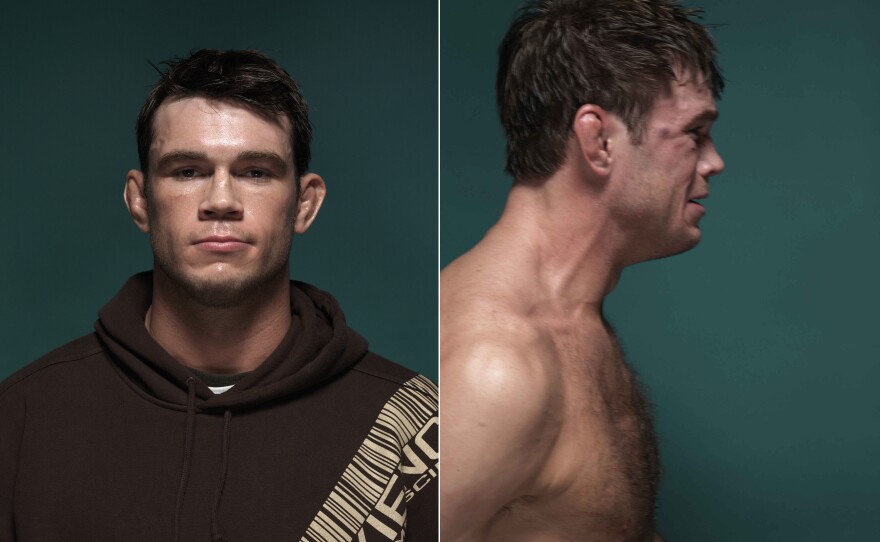The Ultimate Fighting Championship is to a mixed martial arts fighter what the NBA is to a basketball player. It's the league for the best of the best. And the UFC battleground is the Octagon, the metal cage where fights take place. If you've seen any of the fights over the last six years, you've likely seen a tall, lanky photographer perched on edge of the Octagon. That's Kevin Lynch, and he's there because he proposed a photography project to the UFC. "I told them I would need unfettered access to all the locker rooms. I would have to have a spot on the octagon, and I would want to do images that reflect the transition of what a fighter goes through."
To capture that transition, Lynch decided to shoot before and after portraits of the fighters. Veteran art critic Dave Hickey wrote an essay about mixed martial arts fighting for a book featuring Lynch's photography. "For Kevin to address what has to be the most complex and refined type of photography there is, which is sports photography, and to find a way to do that without indulging in the clichés of sports photography, well it showed some beautiful decisions by Kevin."
Hugh Davies is the director of the Museum of Contemporary Art San Diego. He says Kevin "managed to capture the essence of these combatants in a way that elevates it to the level of art." Across one wall of the museum is a grid of 400 portraits of fighters, taken before and after combat. Hugh says, "the personalities of the fighters are very clearly expressed. Some of them are wearing masks, some of them are scowling at the camera, some of them are mugging for the camera."
Lynch adds, "You know a lot of these guys are jumping up and down in front of my camera, they're not just standing there. They are so full of adreniline and they are waiting to go out there and face 20,000 roaring fans." He says getting a fighter to stop for a portrait is a challenge, especially after the fight. They've just been performing at their peak and possibly taking a severe beating. Lynch explains, "Emotions break down afterwards. When they lose, I've seen them cry, I've seen them screaming. It's amazing what they go through because there's so much riding on it."
You can see this post-fight emotion in one of the larger images of UFC fighter Forrest Griffin. In the before image, you see a handsome, clean-cut young man wearing a sweatshirt. The only indication he's a fighter is his classic cauliflower ears. But as Davies explains, the image from after the fight is quite different. "After is agitated, animated, you can see the wounds on his face, his vein is out on his neck. This guy is in extremis and what I don't know is whether he won or lost and it doesn't really matter."
These portraits are full of cuts under the eyes and bent noses, and there is a lot of blood. I asked Hickey, who's seen a plenty of fights, if he ever has to look away. He quickly responded, "No, I mean I live in a world with Robert Mapplethorpe and Matthew Barney. I've seen a lot of stuff from which other people look away. I'm an art critic."
On another wall, there's a large panoramic of a UFC fight at Miramar. The Octagon is surrounded by marines at attention during the national anthem. Hickey says it is the bravery of both soldiers and fighters that he admires and rarely sees in contemporary society. "The culture is so safe and so organized, the occasion to be brave doesn't present itself all that much."
Some may look away from the images in the Octagon exhibit, but those who confront them will see a poignant mix of bravery and violence.







